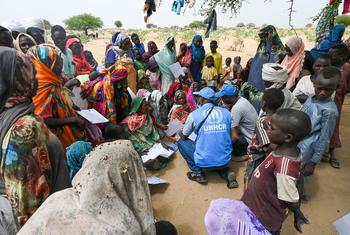Khartoum, June 7Darfur24) The conflict in Sudan has entered its eighth week with fighting between the Sudanese Armed Forces (SAF) and the Rapid Support Forces (RSF) continuing.
The humanitarian situation remains dire in Darfur with increase insecurity and attacks on civilians reported.
Nearly 1.6 million people have been forced to flee their homes since the conflict started and are now displaced inside and outside the country.
At least 68 humanitarian organizations have continued to respond across the country after 15 April.
Despite repeated serious violations of the ceasefire agreement, humanitarian partners have managed to move relief supplies across states to assist 2.2 million people.
Clashes between the Sudanese Armed Forces (SAF) and the Rapid Support Forces (RSF) have continued for over seven weeks, with fighting reported in Khartoum, Al Obeid and different parts of Darfur. Since 15 April, at least 780 people have been killed, and about 5,800 injured across the country, according to the Federal Ministry of Health (FMoH), as of 3 June. The humanitarian situation is particularly dire in parts of Darfur, as reports of inter-communal violence and attacks on civilians have increased. An attack in Kutum, North Darfur, on 3 and 4 June left an unconfirmed number of civilians dead and injured, including in a camp hosting internally displaced people.
During the ceasefire agreement that started on 22 May and expired on 3 June, both parties reportedly committed “repeated serious violations”, including occupation of civilian homes, private businesses, public buildings and hospitals, as well as air and artillery strikes, attacks and prohibited movements, according to a joint statement from the facilitators, the Kingdom of Saudi Arabia and the United States of America. The United Nations Security Council also issued a statement on 2 June strongly condemning all attacks on the civilian population, UN and associated personnel and humanitarian actors, as well as civilian objects, medical personnel and facilities, and the looting of humanitarian supplies. They called upon all parties to ensure rapid, safe and unhindered humanitarian access throughout Sudan.
About 1.2 million people (242,666 families) have been displaced internally by the conflict since 15 April, according to IOM’s Displacement Tracking Matrix as of 29 May. This number is higher than the recorded displacement during the previous four years. Many of them, including children, women, elderly, and others with specific needs, are sheltering in public buildings, or forced to sleep outdoors where they are exposed to severe weather and health threats. Most of the internally displaced people have taken refuge in West Darfur (21 per cent), White Nile (17 per cent), River Nile (15 per cent) and Northern (12 per cent) states. The majority of internally displaced people fled Khartoum (69 per cent). Internal displacement figures include also non-Sudanese nationals who have fled their homes as moved to safer areas. An estimated 150,000 refugees have now independently left Khartoum to relocate in dangerous conditions to White Nile, Gedaref, Kassala and Aj Jazirah States and Port Sudan, according to the Sudanese Commission for Refugees (COR). While the number of refugees in the capital has significantly decreased to less than half of the pre-conflict total and now stands at below 150,000, those still present face a dire situation, ranging from security issues to accessing food and basic services, according to the UN Refugee Agency (UNHCR). In addition, 380,000 people, including refugees, asylum seekers and returnees, have crossed into neighbouring countries as of 1 June, according to the UN Refug

